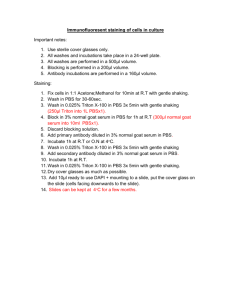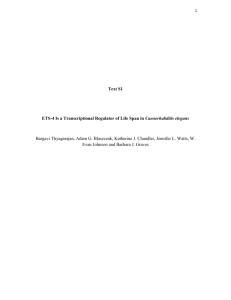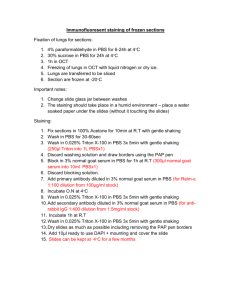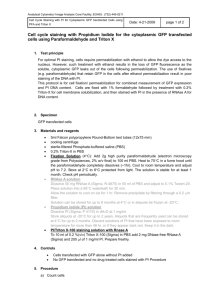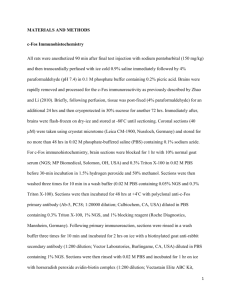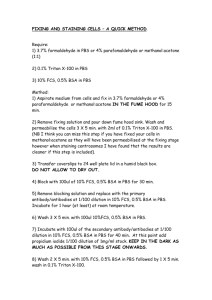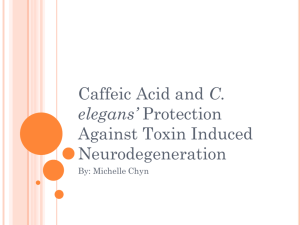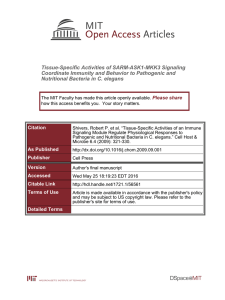supporting material and methods
advertisement
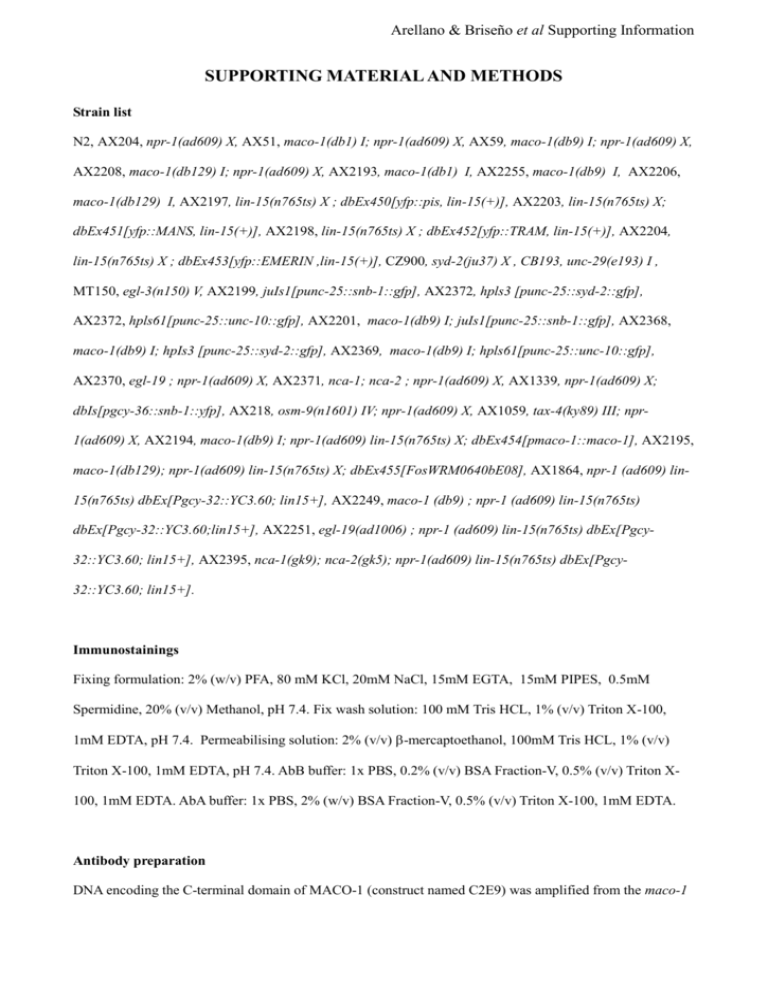
Arellano & Briseño et al Supporting Information SUPPORTING MATERIAL AND METHODS Strain list N2, AX204, npr-1(ad609) X, AX51, maco-1(db1) I; npr-1(ad609) X, AX59, maco-1(db9) I; npr-1(ad609) X, AX2208, maco-1(db129) I; npr-1(ad609) X, AX2193, maco-1(db1) I, AX2255, maco-1(db9) I, AX2206, maco-1(db129) I, AX2197, lin-15(n765ts) X ; dbEx450[yfp::pis, lin-15(+)], AX2203, lin-15(n765ts) X; dbEx451[yfp::MANS, lin-15(+)], AX2198, lin-15(n765ts) X ; dbEx452[yfp::TRAM, lin-15(+)], AX2204, lin-15(n765ts) X ; dbEx453[yfp::EMERIN ,lin-15(+)], CZ900, syd-2(ju37) X , CB193, unc-29(e193) I , MT150, egl-3(n150) V, AX2199, juIs1[punc-25::snb-1::gfp], AX2372, hpls3 [punc-25::syd-2::gfp], AX2372, hpls61[punc-25::unc-10::gfp], AX2201, maco-1(db9) I; juIs1[punc-25::snb-1::gfp], AX2368, maco-1(db9) I; hpIs3 [punc-25::syd-2::gfp], AX2369, maco-1(db9) I; hpls61[punc-25::unc-10::gfp], AX2370, egl-19 ; npr-1(ad609) X, AX2371, nca-1; nca-2 ; npr-1(ad609) X, AX1339, npr-1(ad609) X; dbIs[pgcy-36::snb-1::yfp], AX218, osm-9(n1601) IV; npr-1(ad609) X, AX1059, tax-4(ky89) III; npr1(ad609) X, AX2194, maco-1(db9) I; npr-1(ad609) lin-15(n765ts) X; dbEx454[pmaco-1::maco-1], AX2195, maco-1(db129); npr-1(ad609) lin-15(n765ts) X; dbEx455[FosWRM0640bE08], AX1864, npr-1 (ad609) lin15(n765ts) dbEx[Pgcy-32::YC3.60; lin15+], AX2249, maco-1 (db9) ; npr-1 (ad609) lin-15(n765ts) dbEx[Pgcy-32::YC3.60;lin15+], AX2251, egl-19(ad1006) ; npr-1 (ad609) lin-15(n765ts) dbEx[Pgcy32::YC3.60; lin15+], AX2395, nca-1(gk9); nca-2(gk5); npr-1(ad609) lin-15(n765ts) dbEx[Pgcy32::YC3.60; lin15+]. Immunostainings Fixing formulation: 2% (w/v) PFA, 80 mM KCl, 20mM NaCl, 15mM EGTA, 15mM PIPES, 0.5mM Spermidine, 20% (v/v) Methanol, pH 7.4. Fix wash solution: 100 mM Tris HCL, 1% (v/v) Triton X-100, 1mM EDTA, pH 7.4. Permeabilising solution: 2% (v/v) -mercaptoethanol, 100mM Tris HCL, 1% (v/v) Triton X-100, 1mM EDTA, pH 7.4. AbB buffer: 1x PBS, 0.2% (v/v) BSA Fraction-V, 0.5% (v/v) Triton X100, 1mM EDTA. AbA buffer: 1x PBS, 2% (w/v) BSA Fraction-V, 0.5% (v/v) Triton X-100, 1mM EDTA. Antibody preparation DNA encoding the C-terminal domain of MACO-1 (construct named C2E9) was amplified from the maco-1 Arellano & Briseño et al Supporting Information cDNA and cloned in a His tag containing vector. The construct was expressed in E. coli and the sonicated crude bacterial lysates were passed through a Ni-NTA (Qiagen) column pre-equilibrated with Ni-Lysis Buffer. Fractions were eluted and pooled and dialysed in the presence of 2 mgs TEV protease, and subsequently passed through a second Ni-NTA column. The flow-through was concentrated and run in a gel filtration Superdex-75 column (Pharmacia – Pfizer) previously equilibrated with 1x PBS plus 100 mM NaCl. The eluted fractions were pooled, concentrated, and the final concentration was determined by Abs280nm using a predicted extinction coefficient of 280nm =11,595 M-1 cm-1. Aliquots of the purified domain were sent to Eurogentec (Brussels, Belgium) for the production of rabbit polyclonal antibodies. The purified C-terminal domain (C2E9) was immobilised in HiTrap NHS-activated (1mL) columns (Amersham Biosciences, UK) following the manufacturers protocol. 50 mL of the final bleed of the immunogenised serum were diluted in 2x PBS with 0.1% NaN3 and filtered through a 0.20 m membrane. The diluted serum was circulated overnight at 4 °C through the HiTrap-C2E9 coupled column. The loaded columns were thoroughly washed (>150 column volume) with Wash Buffer and 1x PBS (> 100 column volume). The columns were eluted with 0.1M glycine pH 2.6 in ~1mL fractions, with an immediate pH neutralization with 200 l of 2 M Tris-HCl pH 7.4. The absorbance at 280nm was measured for all fractions, and those with an Abs280nm > 0.1 were pooled and sequentially dialyzed against 1x PBS and then 1x PBS, 60% (v/v) glycerol. Aliquots were prepared, frozen in liquid nitrogen, and stored at –80 °C until further used. Ni-Lysis Buffer: 50mM Potassium phosphate, 300mM NaCl, 10mM Imidazole, pH 8.0, Complete EDTA-free protease inhibitor (Roche Diagnostics, Germany). Ni-Elution Buffer: 50 mM Potassium phosphate, 300 mM NaCl, 250 mM Imidazole, pH = 8.0. Affinity washing solution: 1x PBS, 0.5 M NaCl, 0.1% (v/v) Triton X100. Co-localisation microscopy Images were acquired using an Axio Imager.Z1 microscope with LSM510 scanning module (Carl Zeiss). Images were acquired at between 19 and 22 °C. The objective used was a Plan-Apochromat 63x/1.4 Oil DIC. Each image was scanned four times. Filters used were LP560, BP 420-480, BP 505-530 for channels 1, 2 and 3 respectively. Arellano & Briseño et al Supporting Information SUPPORTING REFERENCES 1. Sulston, J. & Hodgkin, J. Methods. In ‘The nematode Caenorhabditis elegans’, Editor W.B. Wood. CSHL Press, Cold Spring Harbor (1988). 2. Rolls, M.M. et al. Targeting of rough endoplasmic reticulum membrane proteins and ribosomes in invertebrate neurons. Mol Biol Cell 13, 1778-1791(2002). 3. Coates, J.C. & de Bono, M. Antagonistic pathways in neurons exposed to body fluid regulate social feeding in Caenorhabditis elegans. Nature 419, 925-9(2002). 4. de Bono, M. & Bargmann, C.I. Natural variation in a neuropeptide Y receptor homolog modifies social behavior and food response in C. elegans. Cell 94, 679-689(1998). 5. Hart, A.D. Behavior. WormBook, ed. (2006).doi:http://www.wormbook.org 6. Culotti, J.G. & Russell, R.L. Osmotic avoidance defective mutants of the nematode Caenorhabditis elegans. Genetics 90, 243-56(1978). 7. Bargmann, C.I., Hartwieg, E. & Horvitz, H.R. Odorant-selective genes and neurons mediate olfaction in C. elegans. Cell 74, 515-27(1993). 8. Nurrish, S., Ségalat, L. & Kaplan, J.M. Serotonin inhibition of synaptic transmission: Galpha(0) decreases the abundance of UNC-13 at release sites. Neuron 24, 231-42(1999). 9. Krogh, A. et al. Predicting transmembrane protein topology with a hidden Markov model: application to complete genomes. J Mol Biol 305, 567-580(2001). 10. Lupas, A., Van Dyke, M. & Stock, J. Predicting coiled coils from protein sequences. Science 252, 11621164(1991). 11. Zhen, M. & Jin, Y. The liprin protein SYD-2 regulates the differentiation of presynaptic termini in C. elegans. Nature 401, 371-5(1999). 12. Yeh, E. et al. Identification of genes involved in synaptogenesis using a fluorescent active zone marker in Caenorhabditis elegans. J. Neuroscience: 25, 3833-41(2005). 13. Collins, T.J. ImageJ for microscopy. BioTechniques 43, 25-30(2007).
